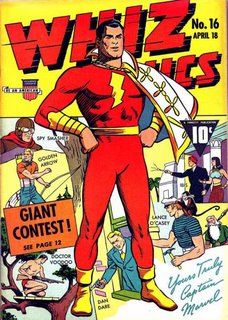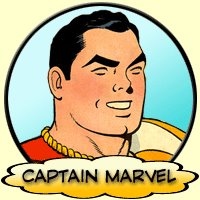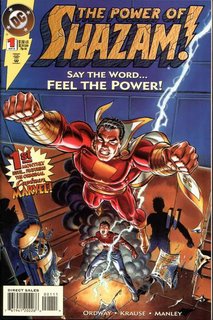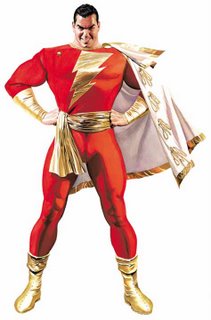The point is that making these characters distinctive and iconic makes them easier to recognize. Batman's shadow cast over a villain makes an effective cover-- Superman's shadow doesn't. If Bruce Wayne had a distinctive, specific face, readers would immediately recognize him when he appeared in a panel or entered a room. In a crowd scene you can pick out Commissioner Gordon, but not Bruce Wayne, and that's messed up!
I guess that all depends on whether it's a panel full of dark-haired tall guys, or a panel of white-haired mustachioed men in trenchcoats, doesn't it? Larsen compares characters like Bruce Wayne to Dick Tracy, suggesting that you would painstakingly recreate Dick Tracy from his creator's artwork, but would have no real model for Bruce Wayne or Superman.
Does anyone see the difference there? I certainly do. Dick Tracy is the product of a single, long-running comic strip, which was done in a very specific, very distinctive style for many years, a style which has been emulated by the other artists who have taken the strip since the creator passed away. Characters like Batman and Superman branched out into other media fairly quickly, appearing in multiple comic titles, radio shows, movie serials, and television. That alone gave people multiple images of the characters. Furthermore, throughout the Batman and Superman stories drawn by the original artists, the style was evolving and changing. Joe Shuster's art in 1938 is quite a bit different from his art in later years. Many of the changes to Superman's costume came while he was the sole artist. Same with Bob Kane's Batman and Bruce Wayne.
Also keep in mind the level of detail available to those early comic artists. I've read quite a few of the DC Archive books (which I would have on-hand, but they're generally, sadly, out of my price range), and characters are often drawn with very little facial detail, or drawn fairly small in order to fit more panels and more text on the pages. I know I've had trouble telling Lois Lane from other dark-haired women in Shuster's art. When the original artists were unable to, or just plain didn't, give their characters "iconic" faces, it became hard for subsequent artists to do so consistently. People like Wayne Boring and Curt Swan and Dick Sprang would be influenced by other media representations of the characters when they came up with their styles, they brought their own visions to Superman and Batman.
Larsen's use of the term "iconic" to describe characters' faces (honestly, who in comics has a distinctive face that isn't due to scarring, weird deformities, or accessories? Take away Wolverine's cigar, pointed incisors, and hair, and can you tell his face from any other stubbled squat stock character?) reminds me of a line from the first issue of Invincible: "Everyone wants iconic costumes, but no one knows what that means." I can tell Bruce Timm's Bruce Wayne from any other Bruce Timm character. I can tell Jim Lee's Bruce Wayne from most, if not all, Jim Lee characters (at least, during his Batman tenure). It's due to the way that each artist defines the character's established features. Every character has certain distinctive traits, and the differences between different artists' portrayals of the characters come from which of those traits they decide to emphasize, and who influences them in those choices. Jon Bogdanove's Superman has a chin that juts out a bit, with a well-defined cleft, big eyebrows, and exaggerated hair that sometimes looks like Egon Spengler's from "The Real Ghostbusters." Tom Grummett's Superman was less exaggerated, gave the character an angular jaw, and put more emphasis on the hard lines of the cheeks and the prominence of his eyes than it did his cleft chin. His hair didn't stick out nearly as much. Ed McGuinness's Superman was somewhere in between, with cartoonish features, an exaggerated angular jaw and eyebrows, and hair that stayed close to his head. Yet, despite all those differences, each one was distinctly Superman.
Why? Because Superman has a series of facial traits (s-curl, black hair, blue eyes, square jaw) that stay constant from interpretation to interpretation. Different artists accentuate those features differently, and fill in the less-well-defined features differently. Rags Morales and Dan Jurgens and Tom Grummett, for instance, all draw Superman's nose differently, because no one has ever really set down the "distinct Superman nose." Shuster mostly just suggested the nose by drawing the bottom of it and leaving the bridge up to the reader's brain to fill in.
Larsen discusses his work on Spider-Man:
When I was drawing the "Amazing Spider-Man," editor Jim Salicrup sent along a page of photocopies with a John Romita drawn Peter Parker and Mary Jane Watson. It was a number of head shots-- showing a range of expressions and whatnot. I learned not to define Peter Parker's cheekbones and to remember MJ's arched eyebrows, dimples and the cleft in her chin.
Yet, he gave Peter far more well-defined cheeks than Romita (who made them less defined than Ditko), a less elongated head, longer, less helmet-like hair with a different hairline (Romita, Sr. gave him a well-defined widow's peak, Larsen gave him a straighter hairline), darker, more exaggerated eyebrows, and a less-square jawline. Larsen himself chose to emphasize certain traits and change others, as any artist does when working with an established character.
But the real "what the hell" moment came when he decided to talk about Captain Marvel.
For years Fawcett's Captain Marvel (later acquired by DC comics) was one of the few characters who had a distinctive face, which was indistinguishable [sic] from all other characters. These days, the guy is almost unrecognizable. He hasn't looked like Captain Marvel in years
I think he meant "distinguishable from all other characters." He goes on:
I can see both sides, I guess. If you're going to hire Jim Lee to draw Batman, you want to see his Batman, not Jim trying to draw like Dick Sprang or Jerry Robinson or Bob Kane or whoever else has been deemed to have drawn the definitive dark night detective. On the other hand, Captain Marvel hasn't looked like Captain Marvel in years! The thing is, it's supposed to be the same guy! It's not as though he's supposed to be somebody else!
Gee, I've taken a look at some of the classic Whiz Comics Captain Marvel covers, compared them with more contemporary visions of the character, and here's what I see (images stolen mostly from comics.org and The Marvel Family Website):




So, either Erik Larsen thinks that rosy cheeks are Captain Marvel's sole defining characteristic and laments the sad state of his fluctuating eyebrow pointiness, or he's talking out of his ass with no idea what he's saying or what point he's trying to make. Anyone want to guess what my choice is?
Every artist has a different interpretation of a character's facial features and structures. The same artist may even interpret the same character differently at different times. The characters remain recognizable not just because of the facial constants, but because of the context of their appearances and the things like clothing and costumes that further define the character. Take away the hat and stripey sweater and put him in a Ditko Spider-Man comic, and "Where's Waldo" becomes a stand-in for Peter Parker. We find meaning and recognition through more than just facial features. Different artists have different interpretations of Jesus, but whether it's euro-Christ or black Jesus or probably-correct Middle Eastern Jewish Jesus, we are able to recognize his Messiah-ness from things like robes, a cross, a crown of thorns, stigmata, walking on water, healing the sick, uniting lambs and lions, or the other things that Jesus is typically shown doing. Take him out of context, and he's unrecognizable from any other long-haired bearded hippie.
Honestly, if any schmoe with a rant can get a weekly CBR column talking about random comic stuff, then sign me up. I guarantee I'd do more research than Larsen (i.e., 'some' as opposed to 'none') and I wouldn't actively try to make the comic industry hate me. Larsen really ought to put more thought into his columns, make them make some sort of sense, some sort of point. Otherwise, why read them? "One fan's opinion" ought to be informed and focused, not the incoherent ramblings of an over-inflated ego. Mr. Larsen, please either spend more than ten minutes deciding on your weekly topic and crapping out a mess of words, or just stop talking altogether.

1 comment:
Oh god, I can't even imagine.
"That's not Bond! Where's his scottish accent and three-o'-clock shadow? God, Bond hasn't looked like Bond in decades!"
Post a Comment